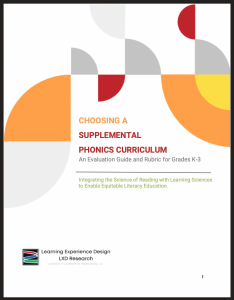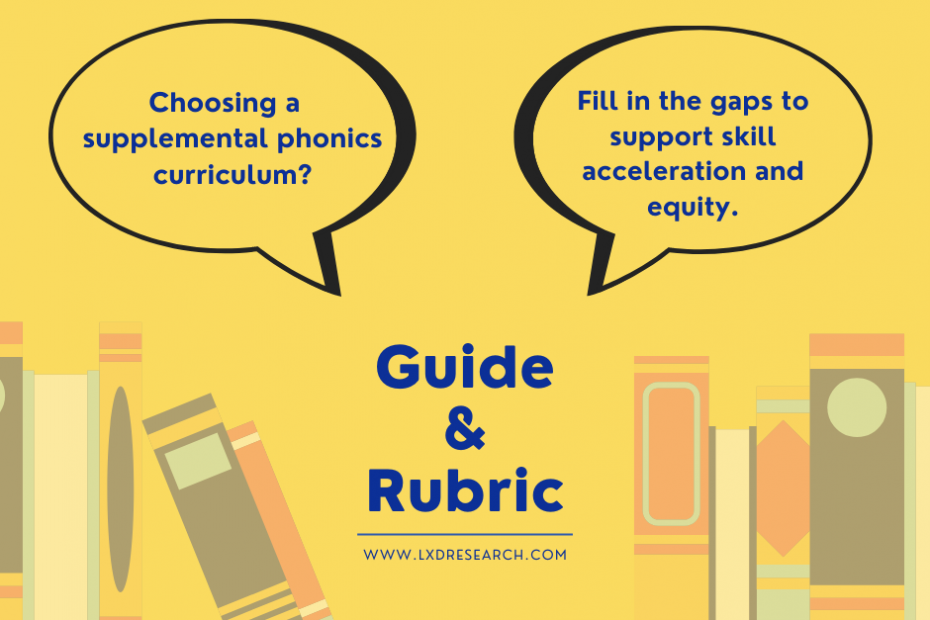A free evaluation guide and rubric to support skill acceleration and equity
Guest author: Kathleen Richards, LXD Literacy and Language Learning Scientist
ELA core programs are one-size-fits “most” learners. They leave gaps. Supplemental phonics programs can help but which one should you choose?
Supplemental phonics programs exist by design to address the structural gaps and issues in the core curriculum. However, it’s up to educators to ensure that they select the right one to fill in the gaps and meet the needs of their particular students. This is a heavy and confusing lift that requires help – a guide!
LXD Research’s pedagogically informed and industry-responsive Supplemental Phonics Evaluation Guide and Rubric exists to help educators identify the gaps in their K-3 core program and select a remediating supplemental program. Grounded in the science of reading and the learning sciences, the guide assists in examining how well programs provide comprehensive coverage of early literacy skills, use a structured literacy approach, and address the unique needs and learning paths of individual students.

What’s in the rubric?
The rubric builds on the previous experience of educators in reviewing programs and aims to help them identify effective supplemental phonics programs, whether they are already in use at the school or district or whether educators are looking for an additional program to fill the gaps. The rubric gives you actionable knowledge about three focus areas:
- Content — “What is being taught?”
- Pedagogy — “How is content taught?”
- Ensuring Acceleration and Equity — “How are all my students’ needs being met?
Content
The Content portion of the rubric walks reviewers through an evaluation of how thoroughly critical areas of early literacy development are covered, including print concepts, phonological and phonemic awareness, basic phonics, advanced word analysis, fluency, language, and writing. The Science of Reading shows that reading doesn’t just come naturally and requires the brain to rewire itself. Teaching all of the critical literacy skills provides students with the foundation they need to develop reading brains.
Pedagogy
If content is like the major structures of a house, pedagogy is like the building methods used during construction. Even if all the parts are there, a sloppy build won’t last long. Successful reading depends not only on teaching the right set of skills, but teaching them in an explicit and systematic way, which is evaluated using the Pedagogy section of the rubric. Students can’t be expected to figure out the complexities of the English spelling system on their own, but they can learn them with direct instruction, modeling, and guided support.
Ensuring Acceleration and Equity
The Ensuring Acceleration and Equity portion of the rubric considers student-centric aspects of supplemental programs to evaluate how adaptable and responsive they are to the various ways people learn, based on research from the learning sciences. Programs that recognize and address learner variability through detailed assessment, meaningful feedback, and targeted practice have the greatest potential to work with the most students. Becoming a skilled reader takes hard work, and struggling with reading is particularly defeating, so motivating features that make students feel engaged and successful can build their confidence and show them the joy of reading.
If your students are still struggling with reading despite being immersed in an ELA core program implemented with fidelity, use the LXD Supplemental Phonics Evaluation Guide and Rubric to identify and invest in curricular approaches and materials that align with the needs and goals of your student cohorts and your learning environment.
How do I start using the Rubric?
Reviewing the content of a program is an active and collaborative process. Download a (free!) copy of the LXD Research Supplemental Phonics Evaluation Guide and Rubric and share it with your team. The rubric is designed for reviewers to rate program materials independently and then come together with information and insight to discuss the data as part of a larger discussion about district learning goals, priorities, and requirements. Make sure to print the Sample Evaluation Worksheet – the Worksheet, like the guide as a whole, is designed to be easy-to-use and customizable to your local needs!

